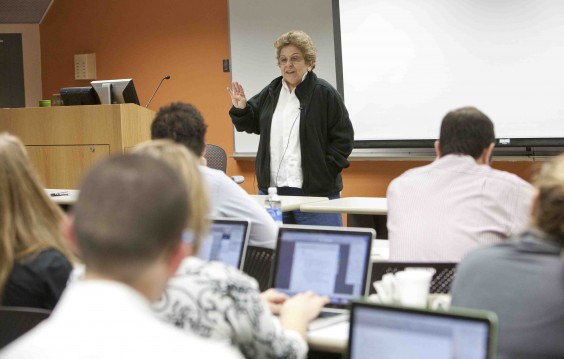
UM President Donna E. Shalala taught the first lecture of the School of Law's new interdisciplinary course The Idea of the Hospital.
The Idea of the Hospital, a new interdisciplinary course offering at the University of Miami School of Law, kicked off on Saturday, January 22, with an in-depth discussion about nursing. UM President Donna E. Shalala led the morning lecture of the all-day session for 21 graduate students from various disciplines: law, engineering, architecture, medicine, business, and epidemiology and public health.
Before addressing the future of nursing from a policy perspective, Shalala, who served eight years as U.S. Secretary of Health and Human Services and more recently co-chaired the Commission on Care for America’s Returning Wounded Warriors, gave an overview of the hospital industry. She explained that the health care system absorbs 30 percent of all U.S. health care dollars, or $788 billion out of the $2.6 trillion national health tab.
“I want you to think though about the power of the institution that you’re about to study,” she said. “How it’s changing—a lot of consolidation going on in the health care business—how it sucks up most of the money in health care, and what the role is of the largest workforce in the institution, and how that role is changing.”
Nurses, she noted, are a hospital’s largest professional contingent. In 2009 Shalala was appointed chair of the Robert Wood Johnson Foundation Initiative on the Future of Nursing, at the Institute of Medicine. After 18 months the committee released its recommendation report, “The Future of Nursing: Leading Change, Advancing Health,” to provide solutions for revving up the health care system as it anticipates an influx of 32 million or so new Americans from the passage of a national health care bill.
“The states are going to have to use all health care professionals in their state to provide access,” Shalala said, detailing systemic improvements and incentives that would include enabling more nurses to achieve higher levels of education, practice to the full extent of their education and training, and function as full partners with physicians and other health care professionals—all with the goal of obtaining better patient outcomes.
Both in and out of hospitals, transforming health care, said Shalala, “involves the personnel that works there, the culture of the institution itself, and how the institution is organized.”
Drawing on expertise from six schools across UM as well as UM Ethics Programs and the Department of Epidemiology and Public Health, The Idea of the Hospital will continue for the next seven Saturdays, delving into a different topic each week: from patient safety to the legal parameters of the hospital-physician relationship to hospital financing to the effect electronic records, design, and technology have on hospitals. The final module compares hospitals around the globe and offers a case study of how they handle crisis situations through the lens of the Miller School’s own Haiti earthquake experience.
Patrick Gudridge, vice dean of the School of Law, came up with the vision for the course. On Saturday he called it “an extraordinary opportunity to recognize how many different modes of thinking about the same institution have developed so intensely side by side—and how difficult it is sometimes for people to develop modes of communication across those intensely worked out ways of thinking and acting.”







